Day 7: Sept 3: Esna
After such an amazing day of things dazzling to the eye yesterday, it was hard to believe we were off again and floated our way towards the city of Esna.
There was always something interesting going on around us: swimming, laundry, fishing and just boating for the joyous fun of it.
Industrious sales people try to sell us cruise tourists their wares by sidling up beside the ship and throwing us things to buy.
I really thought hard about those table cloths, but I really wanted something non-pharaonic.
Eventually the ship pulled up at the town of Esna.
I loved seeing the baker bring out the bread and load the shelves of this bakery.
It was a bustling morning scene and I could almost smell the fresh morning bread!
Again there were many buildings in a dilapidated state of disrepair.
But around the bend there was the Temple of Esna. We arrive at it 30 feet above it, and have to climb down stairs to get to it, because it had been buried in rubble for many years before being excavated fairly recently.
The temple is a relatively small, but well preserved building.
This gives you an idea of the scale.
Construction was begun by Thutmosis III (remember him and the erasure of his step mother Hatshepsut?) in the 18th Dynasty, but little remains from this period.
Most of the temple was constructed in Ptolemaic and Roman times between 40 and 250 CE.
The temple had been more than half buried under rubble and sand for more than a thousand years, which may account for how well preserved it is. Although water and rain did its part to destroy any pigments that might have been on the lower six feet of the columns and building.
Torches from the 18th century and the fact that the temple had been used as a place to store gun powder had caused the higher surfaces to become covered with soot and grime. Animal excrement also played a part in the deterioration as well as fires lit by squatters.
In 2018 a consortium of researchers including the Department of Conservation and the Department of Documentation of the Egyptian Ministry of Tourism (MoTA) along with the University of Tübingen Egyptology Department initiated a longterm project for the restoration of the temple. Christian Leitz and Daniel von Recklinghausen of the University of Tübingen have since published some of the amazing results, which you can read about here and here.
The researchers believe that the Pronaos (portico) was erected under the Emperor Tiberius (14-37 CE) and the decoration of the temple was even later, dating probably to the rule of Claudius (41-54 CE)
Many of the reliefs and paintings show Roman rulers in pharaonic garb and form supported by the gods of Upper and Lower Egypt to suggest that the rule of the invaders is sanctioned by the gods.
The temple was originally dedicated to Khnum, the ram-headed god seen below (I think accompanied here by Hathor).
Here is Khnum with his consort Menhit, the lion-headed goddess they stand before Thoth the Ibis-headed god of wisdom and writing.
This is a shot of the view behind the temple.
Here our guide points out the significance of the horse in the hieroglyphic inscription. Horses were not indigenous to Egypt, but were most likely brought there by the Hyksos in 1500 BCE. Unfortunately I have forgotten the significance here in the Ptolemaic era.
This is what he is pointing to...
There is a horse just before the effaced section of the relief. (far right below).
Here is the King with his captives which he is holding by the hair and smiting in traditional form.
The exterior is covered with interesting reliefs and lettering.
In the image below we see the foreign king being embraced by the goddesses of the two kingdoms, (of lower and upper Egypt represented by the red and white crowns they wear). He holds the goddesses' hands before the god Khnum to show how simpatico he is as the new ruler.
The recent restoration revealed beautiful colors especially in the interior of the temple.
Of course it was dark inside, so my images do not do this temple justice.
Here you can see how brilliant the colors are.
The ceiling was originally completely black, but the restoration again revealed amazing imagery as they removed the soot and grime of the millennia.
The vulture motif is prevalent on the ceiling, being reproduced 46 times and representing the upper Egyptian vulture goddess Nekhbet and the lower Egyptian snake goddess Wadjet (usually shown in the form of a cobra.)
Between the pillars on the ceiling another zodiac was revealed and in the descriptions there are references to constellations we know, but also to some that we do not know. One example was called 'the geese of Ra". There is no visual depiction of the constellation, only a description, so we have no idea what the constellation might have been.
Unfortunately I do not seem to have captured the zodiac although there are figures that resemble it in my shots.
If you look closely you can see the scorpion on the left and the scales (Lyra) in this "borrowed" shot.
Here is a closer look where you can see the scorpion and the crab (Cancer, upper left cut off) for sure.
I believe the images below also show constellations as the sideways man below has stars underneath him and the two-headed ram (or whatever animal that is) is duplicated in the zodiac panel above.
I wonder if the prone man is Orion as he lies near an animal that might be a dog (and reference to Sirius the canine star.)
It looks like there is a procession of gods in little barques also in the middle panel.
Above you can see the way that detail connects to the larger panel.
That row of rams across the top of the next image is pretty cool!
I enlarged this from a corner of one of my shots, so there is a terrible color shift because of the darkness, but it shows Kheper in the back behind the pillar capitals.
Part of the project of restoration was to document all the images in the temple. I would love to have access to that document so I could know exactly what I have looked at. There is Sobek below.
Here we see a Nubian? dancer before Khnum and Hathor.
Below our guide shows the way the Roman invaders used temple reliefs as propaganda to suggest to the common people that the new rulers are sanctioned by the gods.
Here is Khnum holding a was scepter.
This is what the temple looked like in terms of darkness/visibility. In many respects the camera makes it easier to focus on what we saw. You can see that the bottom 6 feet of the temple is devoid of the beautiful color found higher up.
It was of course the recently cleaned ceiling that was most impressive because of the bright colors and clear imagery.
According to the professors from the University of Tübingen, Esna temple is notable for the abundance of floral/fauna depictions on the pillars.
The ptolemaic period has really precise and stunning reliefs. The texture on this column is so impressive.
One last picture of a colorful ptolemaic capital.
Then we had to head back to the ship. On the way we went through a shopping arcade (of course), but this time I actually bought something. Working as a team, a new friend and I were able to get a deal on some figures and a cross.
The soapstone figures I bought at an earlier arcade, but the cats and the other figures were a result of hard bargaining at Esna.
I am quite fond of the cats.
On the way back to the ship, someone wanted to do our shoes. I was wearing suede and my friend had on sneakers, but that didn't deter the shoeshine guys. Here is my friend getting his sneakers polished. (Note the bag of souvenirs hanging down on the right! ;-)
But the day wasn't over yet. The ship cast off and continued southward down the Nile.
Evening is a great time to see water birds feeding.
It was luxurious to be able to sit in our stateroom and look out the big window as I journaled about all the adventures we had had on that day!
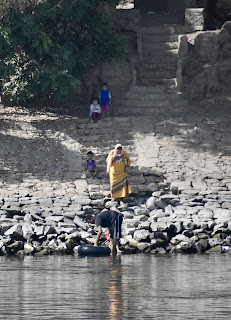






















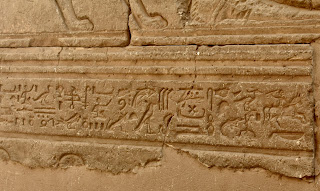














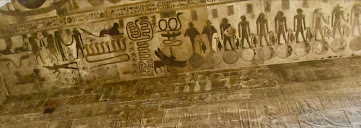


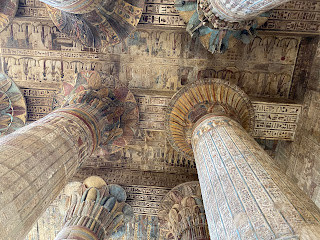

















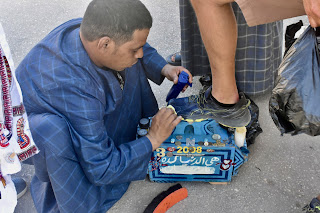





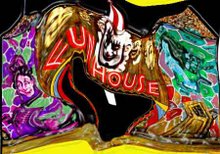

No comments:
Post a Comment